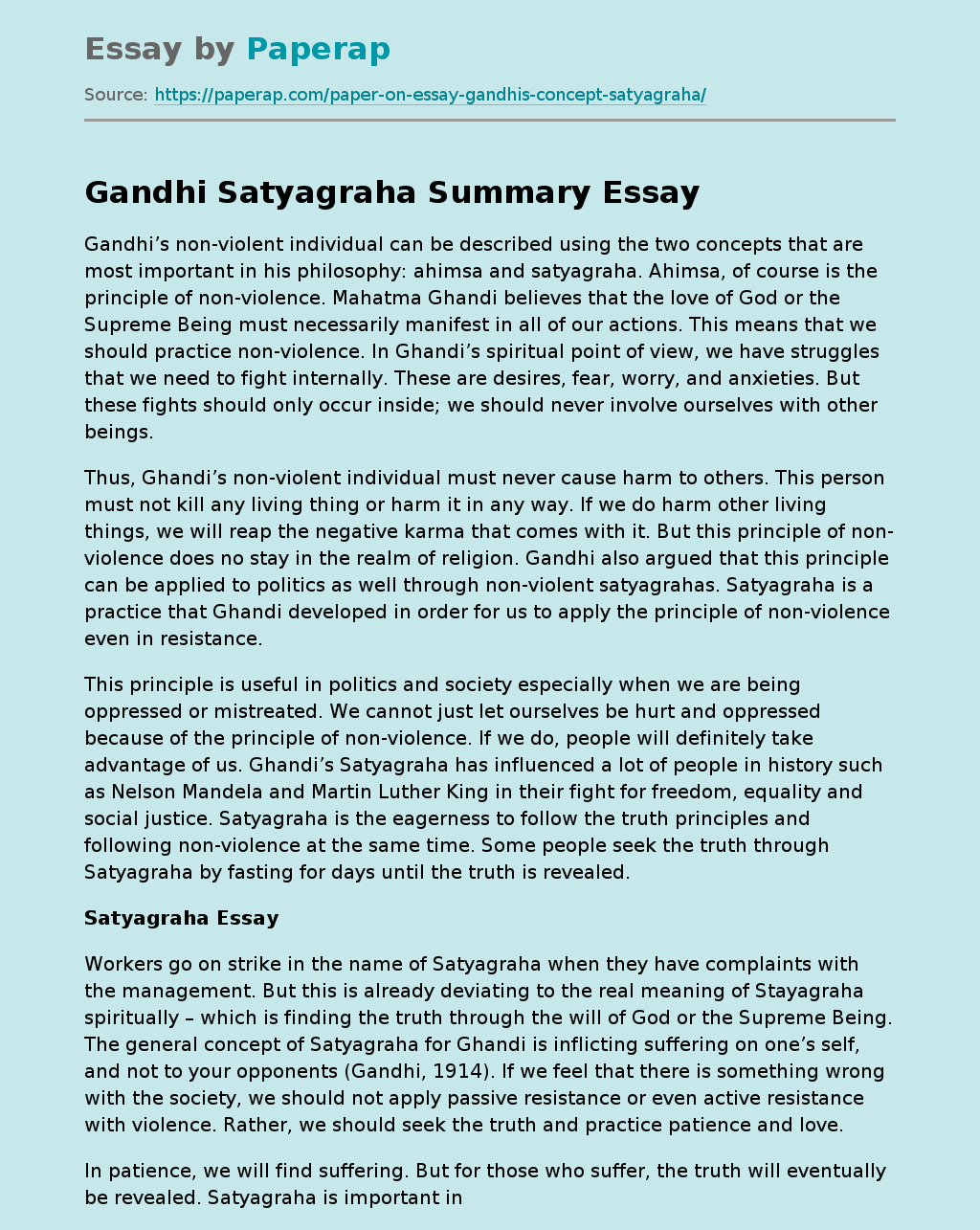Gandhi Satyagraha Summary
Gandhi’s non-violent individual can be described using the two concepts that are most important in his philosophy: ahimsa and satyagraha. Ahimsa, of course is the principle of non-violence. Mahatma Ghandi believes that the love of God or the Supreme Being must necessarily manifest in all of our actions. This means that we should practice non-violence. In Ghandi’s spiritual point of view, we have struggles that we need to fight internally. These are desires, fear, worry, and anxieties. But these fights should only occur inside; we should never involve ourselves with other beings.
Thus, Ghandi’s non-violent individual must never cause harm to others. This person must not kill any living thing or harm it in any way. If we do harm other living things, we will reap the negative karma that comes with it. But this principle of non-violence does no stay in the realm of religion. Gandhi also argued that this principle can be applied to politics as well through non-violent satyagrahas.
Satyagraha is a practice that Ghandi developed in order for us to apply the principle of non-violence even in resistance.
This principle is useful in politics and society especially when we are being oppressed or mistreated. We cannot just let ourselves be hurt and oppressed because of the principle of non-violence. If we do, people will definitely take advantage of us. Ghandi’s Satyagraha has influenced a lot of people in history such as Nelson Mandela and Martin Luther King in their fight for freedom, equality and social justice.
Satyagraha is the eagerness to follow the truth principles and following non-violence at the same time. Some people seek the truth through Satyagraha by fasting for days until the truth is revealed.
Satyagraha Essay
Workers go on strike in the name of Satyagraha when they have complaints with the management. But this is already deviating to the real meaning of Stayagraha spiritually – which is finding the truth through the will of God or the Supreme Being. The general concept of Satyagraha for Ghandi is inflicting suffering on one’s self, and not to your opponents (Gandhi, 1914). If we feel that there is something wrong with the society, we should not apply passive resistance or even active resistance with violence. Rather, we should seek the truth and practice patience and love.
In patience, we will find suffering. But for those who suffer, the truth will eventually be revealed. Satyagraha is important in the concept of Swaraj or self-governance. This originated from Ghandi’s plight to make India free from foreign colonizers. In Swaraj, governance does not come in the form of hierarchy but in community and individual development. Politics is decentralized so that the people can improve themselves by practicing Stayagraha. They will inevitably be patient with one another and contribute to the truth in self-governance.
But they will not be silent about wring and unequal things. In fact, they must be vocal about this such as the social movements that this had inspired in India. Thus, the non-violent person inspired by Satyagarha will be useful in the Swaraj. He must be obedient to the rules in the community by practicing patience and self control. He must seek to improve himself through obedience. Yet, when there is something that needs to be publicly expressed as wrong, the attention of the civil government must be called so that proper action can be taken (Gandhi, 1961).
For example, if a person sees that women’s’ rights is not being given properly, then this non-violent person must let his plight be known. Especially in India, this is a contemporary human rights issue. In a modern world where women are already treated as equal to men, the Indian society still think of women a subordinate. And this is the source of their various practices that are really oppressive to their women. Most Indians believe that women have no decision making capability nor do they have power over money and the household. Because they observe this within the society for so many years, very few have resisted.
Women have been patient and enduring suffering through non-violence. But the true non-violent person according to Ghandi must make this problem known in order for it to be solved. He will fast about it or even hold a strike, but there must be no-violence or retribution is involved. The decision will still be in the hands of the civil government. But he himself will not be oppressive to women, as part of the virtue of non-violence. If we look at the same issue and see what a person with Kant’s enlightenment would do, I can say that he will be courageous and will step up to say what it wrong.
Kant believes that people are not using their intellect and the capability to discern the violations of human rights because they lack courage (Kant, 1784). That is why this person will use his own decisions and intellect in order for the human rights violations against women to be corrected. Most likely, he will seek to tell women to have courage so they could use their own intellect in getting the rights that they deserve as human beings. If a person follows Mill’s concepts in On Liberty, he will be very vocal about women’s rights ecause a person must be sovereign above himself (Mill, 1869). We are not subordinates to other people. So the oppression of women will not be justified according to this person. He will not let women be oppressed and he will most likely teach women on how to speak up for the rights that they deserve and not let other people rule over their lives.
References: Gandhi, Mahatma. “The Theory and Practice of Satyagraha” Indian Opinion, 1914. Gandhi, Mahatma. “Non-violent Resistance (Satyagraha)” 1961. Kant, Immanuel. “What is Enlightenment? ” 1784. Mill, John Stuart. “On Liberty. ” 1869.
Gandhi Satyagraha Summary. (2019, Dec 05). Retrieved from https://paperap.com/paper-on-essay-gandhis-concept-satyagraha/

